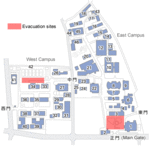Earthquakes
The Great Hanshin Earthquake, which struck Kobe and Osaka in 1995, is perhaps the best known of major earthquakes to hit Japan in the recent past. In 2004, an earthquake of a similar strength hit Niigata Prefecture, in another example of Japan’s vulnerability to these natural events. Residents of Japan should therefore keep themselves informed of the latest evacuation instructions and be prepared for natural disasters. NHK (Nippon Hoso Kyokai, or the Japan Broadcasting Corporation) provides warnings of major natural disasters and advice in their aftermath in English on the TV second sound channel and on Radio Station No. 2 (693 KHz).
Preparing for Earthquakes
To keep damage from earthquakes to a minimum, it is important to be prepared.
- Secure furniture that may topple over easily, such as drawers and bookshelves, with braces. Do not leave items in high places.
- Keep a fire extinguisher handy and make sure that you are aware of the location of the nearest fire extinguisher.
- Prepare an emergency backpack (with such items as first-aid equipment, daily sundries, and valuables). In particular, be prepared to take your passport, foreign resident registration card, and health insurance card with you in cases where it becomes necessary to evacuate.
- Participate actively in disaster-prevention drills conducted in your local community.
- If you live with family, make sure to know each other’s telephone numbers and decide in advance where you should meet after a major disaster.
When an Earthquake Strikes
Even the most violent of tremors lasts for only about one or two minutes. It is said that aftershocks are generally smaller than the major tremor. When an earthquake strikes, remember the following points so that secondary disasters, such as fires and serious injuries, do not occur.
- Turn off all sources of fire (gas equipment, electric appliances, etc.).
- Open a door or window to secure an exit. Do not rush outside in a panic because there is danger of falling items, such as falling billboards.
- Protect yourself by crawling under a sturdy table or desk or some other item of furniture.
- Obtain accurate information from such sources as TV or radio.
- Check on the safety of your neighbors and assist them if you can.
- If you are outdoors, avoid going near objects that may collapse (walls, gate posts, etc.).
Please note that the evacuation sites on campus are as follows:
- East Campus: Main gate north side plaza (roundabout)
- West Campus: Near the tennis courts. Please be sure to check the location of the nearest evacuation site to you in the neighborhood where you live.
Items to Have on Hand in Case of Disaster
Mineral water, preserved foods, flashlight, undergarments, medicine, sturdy gloves, pocket hand-warmers, medical masks, towels, tissues, matches, candles, paper cups, paper plates, and a portable radio
Created: March 29, 2010 / Last modified:September 24, 2025

